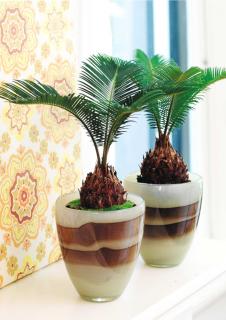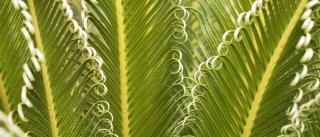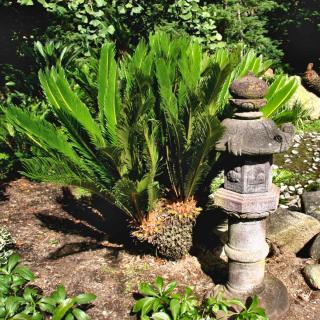

The specific care that’s needed for a cycas, how and when it should be repotted and watered and diseases that infect it.
Core Cycas facts
Name – Cycas
Family – Cycadaceae
Type – indoor plant
Exposure – well-lit, full sun – Soil – soil mix – Foliage – evergreen
These are the answers to the many questions that can arise when one has the luck of owning a magnificent cycas.
Not quite a palm tree but still an amazing ornamental plant, cycas is very appealing.
Cycas requires good soil mix that can be amended with ⅓ compost, if you’ve got any.

Generally speaking, most cycas don’t tolerate the cold, except Cycas revoluta which survives temperatures just below freezing.
Under our climates, cycas adapts well to living indoors in our homes and apartments, except for Cycas revoluta which quite appreciates cooler temperatures in winter.
Choose for it a place near a window facing to the South or West so that it would bathe in a good deal of both indirect light and sunlight.
If you live in a house that is quite dark, avoid purchasing Cycas because it won’t cope well with the lack of luminosity.
Finding the right balance is the key…
This is usually the time of the year when cycas grows most.
Water regularly while letting the soil mix dry in the surface before watering again.
Watering must be regular but limited, in order to not suffocate the plant’s roots.
You might say that watering every 2 or 3 days is often needed.
Start reducing the watering: water needs begin to decrease.
Only when the soil is dry down to the first inch or so (a couple centimeters), water to moisten the entire soil mix clump again.
One could say that watering once every 15 days should be enough.
But this also depends on where your cycas is placed: if in full sun, its needs will surely be higher.
This plant needs much more nitrogen than it does phosphorus and potassium. In conventional fertilizers, this means the “N” ratio must be higher than that of the “P” and “K”. For example, an 18 – 8 – 8 or a 24 – 8 – 8 fertilizer is perfect. Typically, manure has lots of nitrogen, with that from birds and goats being the highest. There are other ways to increase nitrogen content though:
 use lawn trimmings for mulch. This grassy mulch breaks down fast and releases lots of nitrogen.
use lawn trimmings for mulch. This grassy mulch breaks down fast and releases lots of nitrogen.This is undoubtedly due to lack of light or excess water.
If the plant continues to produce new leaves, this is part of your cycas’s natural cycle. Trees, even evergreen trees, lose their leaves to renew them.
You should know that once a leaf turns yellow, be it due to pests, frost, or lack of nutrients, that same leaf won’t turn green again. You’ll have to cajole the plant into setting out new, healthy fronds!

All in one aesthetic, resilient and very easy to grow, this is one of the most appreciated and often-purchased indoor plants. Outdoors, it adds a timeless feature to the garden, slowly evolving. It is native to Japan, which makes it a perfect complement to any Japanese garden.
Its foliage is particularly elegant and unique, and its thick trunk brings a touch of exotic life to a living room, dining area, or any other room of the house that is well-lit.
Cycas is one of the plants that date back to the time of dinosaurs! Like the ZZ plant or the Ginkgo biloba tree, cycas leaves routinely appear in fossils that are over 60 million years old.
Read also:
Sorry but no… adding gravel to the bottom does not help drainage at all, it makes your soil wetter. You can understand that here.
Hi Tim, I understand that the drainage for the soil itself is unchanged by the gravel, you’re right on that. It does however help avoid clogging for the plant pot: usually for cycas it’s a fairly large pot, clay more often than not, and those often have but one single hole in the center for extra water to drain out. Gravel keeps the hole from clogging.
For the soil, it’s best to amend the entire soil mix with sand, perlite, vermiculite and the like to modify water retention properties. Thanks for chipping in!
Thank you for the article, it’s really helpful for beginners
Thanks for saying so, it’s nice to know you liked the article!
What type of fertilizer do you recommend? Once the leaves are a little yellow do they return to green?
Hi Sandy, for cycas it’s recommended to have lots of nitrogen in your fertilizer. The first number in the group of three should be the highest – that’s the N for nitrogen in NPK. Manure in general is excellent, chicken and goat manure being the best, but there are lots of other options. And no, a leaf that has turned yellow will not revert to green 🙁 but there will be new sprouts coming up to replace the old leaves!